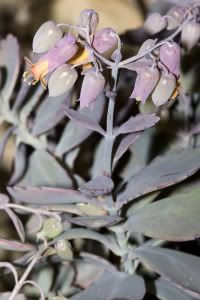Research into desert plant could help development of energy crops for arid regions
 Scientists at the University of Liverpool are investigating how a Madagascan plant could be used to help produce crops in harsh environmental conditions. The plant, Kalanchoe fedtschenkoi, is unique because, unlike normal plants, it captures most of its carbon dioxide at night when the air is cooler and more humid, making it 10 times more water-efficient than major crops such as wheat.
Scientists at the University of Liverpool are investigating how a Madagascan plant could be used to help produce crops in harsh environmental conditions. The plant, Kalanchoe fedtschenkoi, is unique because, unlike normal plants, it captures most of its carbon dioxide at night when the air is cooler and more humid, making it 10 times more water-efficient than major crops such as wheat.Kalanchoe is a good example of how plants can flourish in harsh environments. If we can understand how it is able to photosynthesise using much less water than current crops, we may be able to use its genetic code to develop a crop able to withstand harsh environmental conditions. - Dr James Hartwell, biological scientistThe scientists will use the latest next-generation DNA sequencing to analyse the plant’s genetic code and understand how these plants function at night. The project will generate a genome sequence database that will be used as an Internet resource for plant biologists throughout the world.
The researchers believe that the novel genes found in Kalanchoe could provide a model of how energy crops could be grown on un-utilised desert and semi-arid lands, rather than on farmland needed for producing food:
 energy :: sustainability :: biomass :: bioenergy :: biofuels :: energy crops :: photosynthesis :: water :: efficiency :: deserts :: arid :: Madagascar :: biotechnology :: plant biology ::
energy :: sustainability :: biomass :: bioenergy :: biofuels :: energy crops :: photosynthesis :: water :: efficiency :: deserts :: arid :: Madagascar :: biotechnology :: plant biology :: The genetic code of the plant will be deciphered using a DNA sequencing machine that uses an enzyme found in fireflies as a flash light to help read the DNA strand.
Liverpool is one of only two universities in the UK with the technology, which can read up to half a billion DNA letters in a few hours compared to more widely used technology that can only process 50,000.
The project is funded by the Biotechnology and Biological Sciences Research Council (BBSRC).
Image: Kalanchoe fedtschenkoi. Credit: Wikimedia commons.
References:
University of Liverpool: Desert plant may hold key to surviving food shortage - June 19, 2007.
 --------------
--------------
 Mongabay, a leading resource for news and perspectives on environmental and conservation issues related to the tropics, has launched Tropical Conservation Science - a new, open access academic e-journal. It will cover a wide variety of scientific and social studies on tropical ecosystems, their biodiversity and the threats posed to them.
Mongabay, a leading resource for news and perspectives on environmental and conservation issues related to the tropics, has launched Tropical Conservation Science - a new, open access academic e-journal. It will cover a wide variety of scientific and social studies on tropical ecosystems, their biodiversity and the threats posed to them.









0 Comments:
Post a Comment
Links to this post:
Create a Link
<< Home